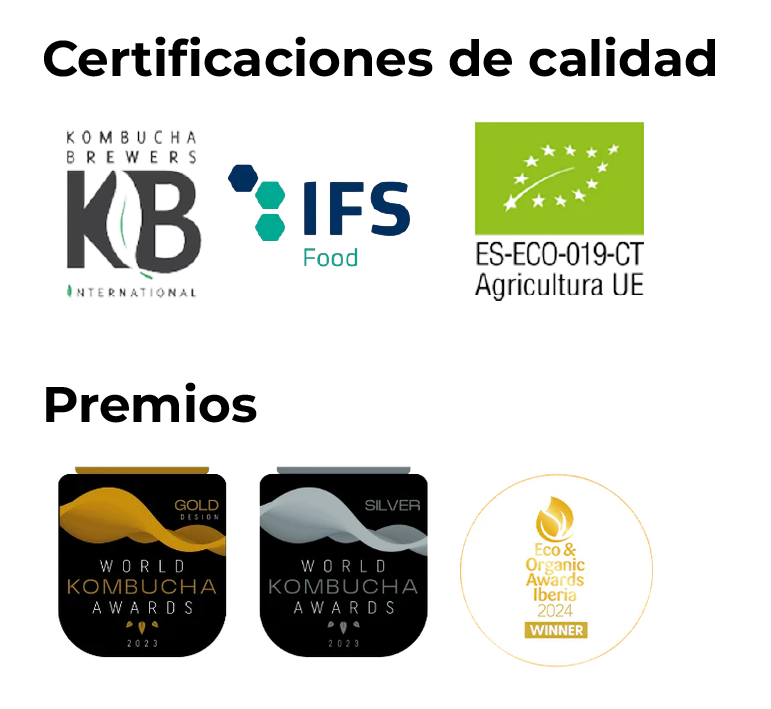AUTHENTIC KOMBUCHA. HOW TO GET TO KNOW IT?
The world of fermented foods is booming. Although this system of food transformation is as old as mankind, there are many people who speak of the health benefits of its consumption. Taking advantage of this trend, many brands have emerged recently that are dedicated to the commercialization of this type of food. If we narrow the field of vision and refer only to kombucha, since Mūn Ferments came on the market in 2015, companies have been emerging that also sell fermented tea.
There are no regulations governing what can be marketed under the term kombucha. The Kombucha Brewers International, or KBI, where Mūn Ferments has been a member since 2017, has a code of good practices, where its associates have detailed the different types of kombucha that can be brewed. Thus, we can find:
Traditional kombucha: Traditional beverage obtained from the fermentation of a sweetened tea infusion, SCOBY, starter liquid, with a sour and sweet taste at the same time, with bubbles and very low alcohol content, and without any further processing at the end of fermentation. Natural flavorings (fruits, herbal teas, etc.) can be added. This traditional kombucha is capable of creating a natural SCOBY if left at room temperature and with the presence of oxygen.
Kombucha: a beverage obtained from the fermentation of a wide range of plants, SCOBY/starter, water and fermentable sugar. Flavorings can also be added. Depending on the process used, it may or may not generate SCOBY at room temperature.
Kombucha soft drink: or processed kombucha includes any type of kombucha that has undergone a process outside the traditional method. Some examples of these processes would be pasteurization, dealcoholization, filtration to change aroma or appearance, sterilizing filtration or dilution.
Since all this information does not always appear visibly on the product label, the best thing to do is to analyze a series of aspects that will help us validate if what you have in your hands is or is not a quality and authentic kombucha. Reviewing the packaging, the label and the liquid will surely help you when you are in front of a Mercadona or Carrefour fridge, and you doubt whether to take that kombucha home.
The packaging of a kombucha
Currently, kombucha is available on the market in 4 types of packaging. Each one offers some advantages, but also some disadvantages:
In glass: A kombucha packaged in glass a priori already offers a good guarantee, since it is the best material to be in contact with the kombucha. The glass is inert and does not transfer particles to the kombucha that we will end up drinking. In addition, it is absolutely recyclable and reusable.
In cans: Aluminum cans can be a good solution for kombucha, but we must not forget that there is a plastic coating inside, which can sometimes include bisphenol A (BPA). BPA is a substance that is added to obtain better properties, but at the same time, it is an endocrine disruptor, i.e., it is capable of altering our hormonal cycle. BPA is a xenoestrogen and behaves in the body like a female hormone, which can have serious consequences on the consumer’s health. For this reason, it is best to make sure that the packaging clearly indicates that the can does not contain BPA.
In plastic: Kombucha is a very acidic drink, with a pH around 3, so a plastic container cannot guarantee that there will be no migration of particles from the container into the drink. For this reason, it is best to avoid drinking kombucha in plastic containers.
In keg: Bulk kombuchas are stored in barrels or kegs. Stainless steel kegs are the best solution, but sometimes single-use plastic kegs are used to avoid the return of packaging. The kegs we use at Mūn Ferments contain a BPA-free aluminum inner bag, so there is no particle migration.
How to read the label of a kombucha bottle
The label of a kombucha bottle can include a lot of information or, on the contrary, very little. By interpreting its contents, we can find out whether or not it is a good kombucha. We will have to read this carefully:
the list of ingredients
the nutritional table
the method of preparation
claims and other notes
The list of ingredients of a good kombucha
Ingredients on a label must always be ordered from most to least, according to the quantity used. It is only mandatory that the % of those mentioned on the label appear. A good kombucha should include at least this list: water, sugar, tea and kombucha culture. Any fruit, root or infusion used for flavoring can be added to the list, such as ginger, turmeric, lemon or pepper, to name a few.
Always be hesitant about a kombucha that contains ingredients that do not fit the traditional brewing process. Sparkling water? What would be the point of heating sparkling water to prepare the tea brew? No point. This is already a clue that it is more a soft drink than a good traditional kombucha.
Sugar is essential to make kombucha, because it will be the fuel used by the yeasts and bacteria for the production of organic acids. When you see in the list ingredients such as: steviol glycosides (or E-960), these are sweeteners that are added with the aim of making it more sweet, more appealing to the palate of more public. Be careful not to be taken for a ride.
The nutritional table of a kombucha
It is often scary, especially when you are on the healthy side of food, that sugar is an ingredient in the composition of a product. In the case of kombucha, it is a must. Without sugar, there is no kombucha. The microorganisms that make fermentation possible use it as fuel to carry out the process. The crux of the matter is that the production process has been rigorous and as careful as possible to ensure that these microorganisms consume practically all the sugar and convert it into super-healthy organic acids. Patience and time versus immediacy. A slow drink with a long fermentation will guarantee this point.
A kombucha with more than one gram of sugar per 100 ml will certainly be less expensive to drink for the beginner, but we also assure you that it will be less healthy compared to what it is sold as.
An additional trick? If it’s artisanal and doesn’t need a fridge, you’ve found your kombucha! As long as you make sure it is not pasteurized. The less sugar it contains, the less cold it needs to keep.
Be careful with the nutritional tables in which carbohydrates differ from sugars. It is clear that sugar does not evaporate and that it remains somewhere. If there is a very important difference, think that it is not a clean figure at all. In other foods, the difference could be explained by the starches it contains, but this does not occur in kombucha.
How and with what have they brewed it?
An authentic kombucha must have followed the traditional method of elaboration. It must have started from a tea infusion (tannins are essential) that has been left to ferment with a colony of microorganisms, known as SCOBY.
The ingredients it contains must be natural. Discard a kombucha with concentrated ingredients, with flavorings and colorings. It is also important that the origin of these ingredients is organic. The organic seal that appears on a label is the guarantee that the product does not contain pesticides or GMOs.
Your palate will also help you to decide. If it reminds you of that candy or chewing gum you once ate, it is probably not as natural as it is sold.
No pasteurization, please
Heat and kombucha should only be together during the beginning of the brewing process. Subjecting the drink to pasteurization will only eliminate those natural probiotics that have managed to emerge during its elaboration, which are precisely responsible for a large part of its properties. If it is unfiltered, you may also be lucky enough to see some SCOBY (Symbiotic Colony of Bacteria and Yeasts) that has made it possible for the magic of fermentation to turn what was just a tea brew into a beverage loaded with healthful properties.
We have very good news. All these conditions are met by Mūn Ferments. 100% natural and organic ingredients, local as far as possible and an elaboration process based on research achieve the healthiest kombucha. With a long fermentation of at least one month’s duration, it contains a maximum of 1.8 grams of sugar per 100 milliliters.
Place your order and enjoy it as soon as possible. You can find it in more than 8,000 physical points of sale and in our online store.






